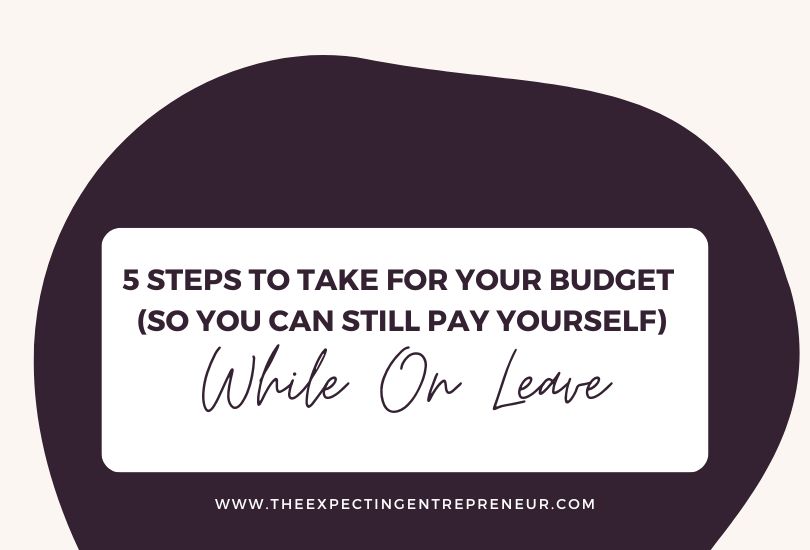Money. It’s on every business owner’s mind, and I’ll dare to say that for the pregnant business owner, I’ve seen finances be the thing that makes taking maternity leave seem extra daunting. In most countries, there simply aren’t any financial protections for self-employed women who are having a baby. That’s why I’ve brought in the expert, Jen Hemphill, to talk about concrete steps you can take to plan and budget for your business to be babyproofed when it comes to paying for your maternity leave.
Planning for a baby is exciting and nerve-wracking all at the same time. I have been there twice with my two boys.
The money part can be the most stressful part, but doing some planning ahead will save you time (your little one will no kidding take most of your time) AND make your life so much easier.
For managing your business finances I highly recommend implementing the Profit First method by Mike Michalowicz, the book is an easy read so definitely put it on your reading list. If you are already using his method you will find planning your maternity leave easier.
In planning just remember this doesn’t all fall on you, the baby was a team effort and making the financial adjustments should be one too. As women, we like to do it all but the reality is that we don’t have to!
Let’s get to business (pun intended) and start discussing these 5 steps so you can make your money planning easier starting now.
STEP #1: Assess the health of your cash flow in your business & household AND know your bottom-line
Chances are you know your business numbers better than your household numbers. Knowing BOTH will make it easier and more effective with planning your budget for your maternity leave.
After accounting for all expenses what do your personal and business accounts look like these days?
Are you surviving paycheck to paycheck with each? Do you have a nice cushion of money after all your expenses are taken care of?
Where do you stand? What is your bottom-line?
Income – Expenses = Your Bottom-Line
Your bottom-line is the extra money leftover after you pay all of your bills (or it can also mean how much money you are over spending if it is a negative number). You need to know the specific dollar amount of this bottom-line for your business and personal money. If there isn’t too much wiggle room OR you are in the negative you need to know by how much!
You don’t need to fear this because once you know the number then you can adjust your money plan (your budget) as necessary. The key is knowing this number.
If your bottom-line is lacking, if you are surprised or if it is not where you want it to be don’t worry you are not headed for doom and gloom, there are 2 things you can do:
1. Re-look at your expenses with a fine-tooth comb and see which ones you can cut out or minimize
2. Figure out how to bring in more income (remember this is a team effort especially when dealing with your personal finances!)
The point here is to get that bottom-line number to feel good to you. There is no exact dollar figure here to aim for because each situation is so unique.
STEP #2: Assess how DEPENDENT your business and household is on YOU
Now that you have your bottom-line number you can move forward to see how dependent your business and household income is on you. This way you can plan and adjust your life as necessary.
- How dependent is your business on you to bring in money? What percentage of your business revenue relies on you to do the work?
- How dependent is your household on the money you bring in from your business? What percentage of your household income comes from your business?
What is this percentage in dollar figures? How about on a monthly basis?
- Does your household number fall in line with what you pay yourself monthly? Are you finding that you are having to pay yourself more to meet the needs of your household?
- For your business what can you do to generate more revenue that doesn’t rely on you to be there?
Figure out what changes you need to make and then re-calculate these numbers as necessary.
STEP #3: Estimate the added costs of the new baby
Of course, we know babies bring added costs (in addition to the nice tax break). Be sure to do a brain dump of all the potential costs in your particular scenario: diapers (cloth/disposable), baby wipes, crib, car seat, stroller, etc.
Don’t just do the list of items, but take the extra step and put the approximate cost next to it. Some will be a one time expense, but others will be a recurring expense.
Yes, you won’t know how many diapers your baby will go through in a month, but you can ask a friend. It doesn’t have to be perfect, it just gives you a start.
Once you do this come up with a rough estimate of this cost per month and then move on to the next step.
STEP #4: Decide how long you want your maternity leave to be
I probably don’t have to mention to you that this is crucial to know ahead of time. In knowing how long you will be stepping away from your business will allow you to plan well so you can still account for your monthly salary.
Are you going to be away for the traditional 6 weeks? 3 months? Longer?
Decide on this and know the total amount for your salary during that leave.
STEP #5: Make the necessary tweaks to your budgets (both household and business)
- You have your bottom-line figure in a healthy state. This is the extra money to help you minimize any potential gap in money.
- You have the figures of how much your household and business is dependent on you. You know your current monthly pay that you would like to maintain and you can start thinking on how to lessen the dependency on you in your business revenue.
- You have an approximate monthly figure of what the added costs of the baby are. This is the extra money you need to start to account for now.
- Use these figures when making any necessary tweaks to your current household and business budgets.
Remember to always be flexible, patient and confident in the process. Expecting a baby is a treasured and memorable time in your life– enjoy it as the money “stuff” with some planning will work out!
BONUS TIP: Some points to consider post-maternity leave
- Once you resume business from “being away” how much are you going to be working? Are you planning on resuming the same number of hours you were working before the baby?
- Your little one is going to take more time than you think, just count on that. We like to be optimistic on all the things we are going to tackle post-baby, but with the baby it doesn’t happen like we want it to. We need to give ourselves the grace and permission that it is completely ok!
- Are you going to get a babysitter? Use day care? Or a nanny? How much is that going to cost you on a monthly basis?
- Maybe you are considering outsourcing more work, what is the cost of this going to be? How does this fit in your overall financial picture?
- Consider your business model, if it is more service based you may think about re-assessing your pricing and/or including more digital options.
Want more resources about budgeting for your leave? Check out Chapter 5 of The Expecting Entrepreneur.
Jen Hemphill helps busy determined women who are content with their income but not their bank account. She helps them transform their finances from being overwhelming to bringing them financial confidence, control and freedom. She is a Motivational Money Coach, an AFC® (Accredited Financial Counselor) and host of the Her Money Matters Podcast. When she’s not talking money, she enjoys photography, coffee, chocolate, traveling, working out and spending time with her husband and two boys.



